Opening a medical spa is both a thrilling and challenging venture, involving regulatory navigation, equipment leasing, and patient retention strategies, whether you're experienced or new to the field.
Medical spas are like the elegant sibling of traditional spas, merging aesthetic relaxation with medical treatments performed under a physician's watchful eye.
Distinguishing between aesthetic and medical spas is crucial for practitioners to effectively meet client needs and provide the appropriate services.
If you’re in the process of opening a medical spa, then unique challenges and excitement lie ahead.
From navigating the regulatory hoops and ensuring compliance to leasing equipment and improving patient retention, there’s a lot to consider on this journey.
Whether you’re an experienced practitioner looking to expand or someone new to the industry, this insider’s guide is here to provide you with the support you need to open a medical spa.
I’ll share a step-by-step guide, along with insights on costs and equipment, to help you tackle the complexities of running a successful medical spa. I’ll also throw in a few bonus tips.
Let’s get started.
What Is a Medical Spa?
Think of a medical spa, or med spa, as the slightly more sophisticated sibling of a traditional spa. It’s got all the relaxing elements and services of an aesthetic spa, along with the addition of medical treatments.
Medical spas offer a range of cosmetic and rejuvenation services, all of which are performed under a licensed physician.
Essentially, running a medical spa is about pampering your clients while board-certified and licensed professionals work their magic.
Aesthetic Spas vs. Medical Spas
As a new practitioner, understanding the distinction between aesthetic and med spas will help you better cater to the specific needs of your clientele.
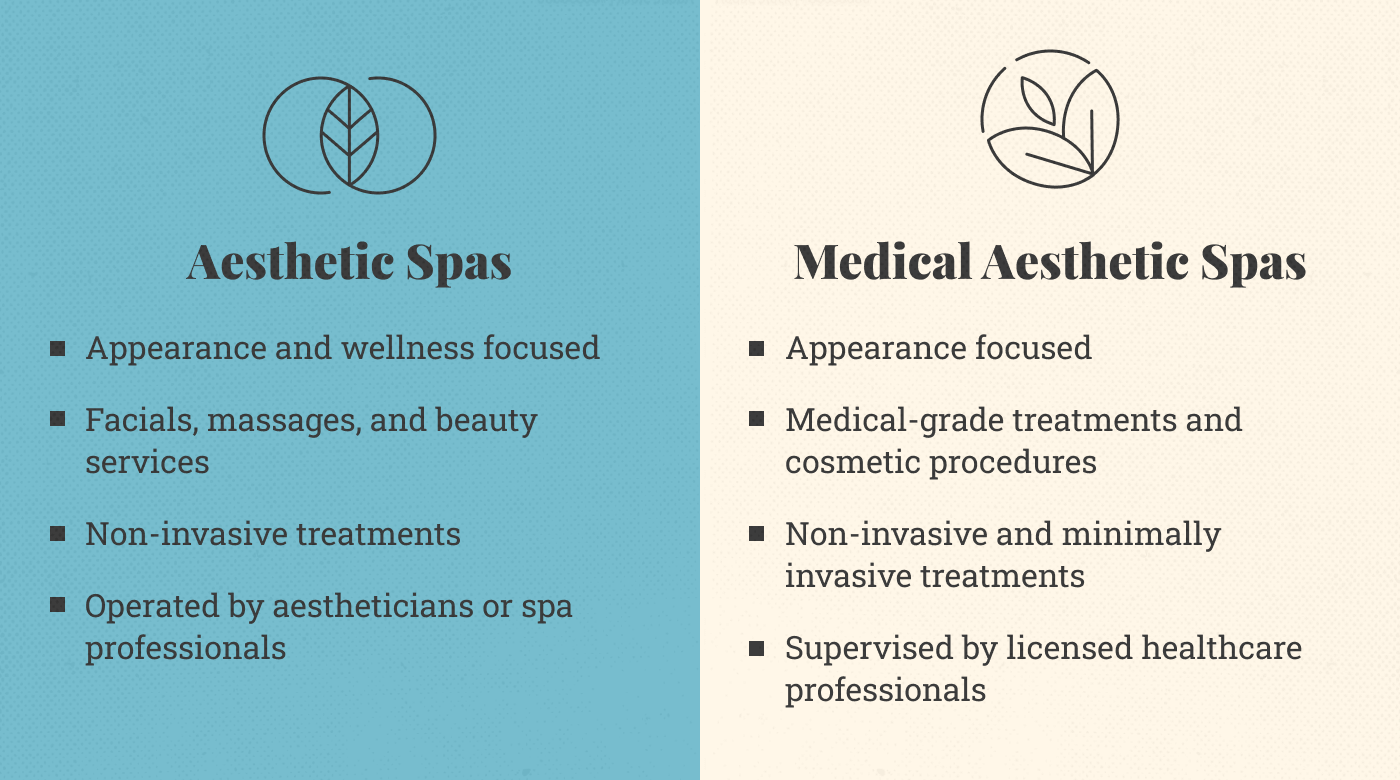
Aesthetic Spas
Aesthetic spas are those spas we picture ourselves indulging in after a long, long week at work—you know, the ones with incense and cucumber water.
The focus of an aesthetic spa is on providing aesthetic treatments that enhance the client’s appearance and well-being. Think facials, essential oil massages, body treatments, and waxing. The main goal is to leave clients feeling refreshed, relaxed, and glowing from head to toe.
Medical Spas
Medical spas offer both medical treatments and relaxing spa services.
Under the guidance of licensed physicians, clients can choose from a wide range of non-invasive or minimally invasive medical procedures to improve their appearance. These include botox injections, dermal fillers, laser hair removal, and chemical peels.
The main difference between an aesthetic spa and a medical spa is that the latter aims to deliver results-driven treatments that are backed by science and performed with professional expertise.
So, while aesthetic spas emphasize overall well-being and relaxation, medical spas provide a transformative experience for clients who not only want to be pampered but are also looking for solutions to their cosmetic concerns.
The Startup Cost of Opening a Medical Spa
When it comes to launching your medical spa, you need to know your budget.
On average, you can expect to spend around $19,267 for initial expenses, excluding equipment leasing costs. Leasing essential medical spa equipment can add $50,000 to $80,000 to your budget.
But don’t let the initial costs discourage you from your dream of running a medical spa. With careful budgeting and a well-thought-out financial management plan, you can prepare yourself for success.
Initial Costs
Opening a medical spa involves the following initial costs:
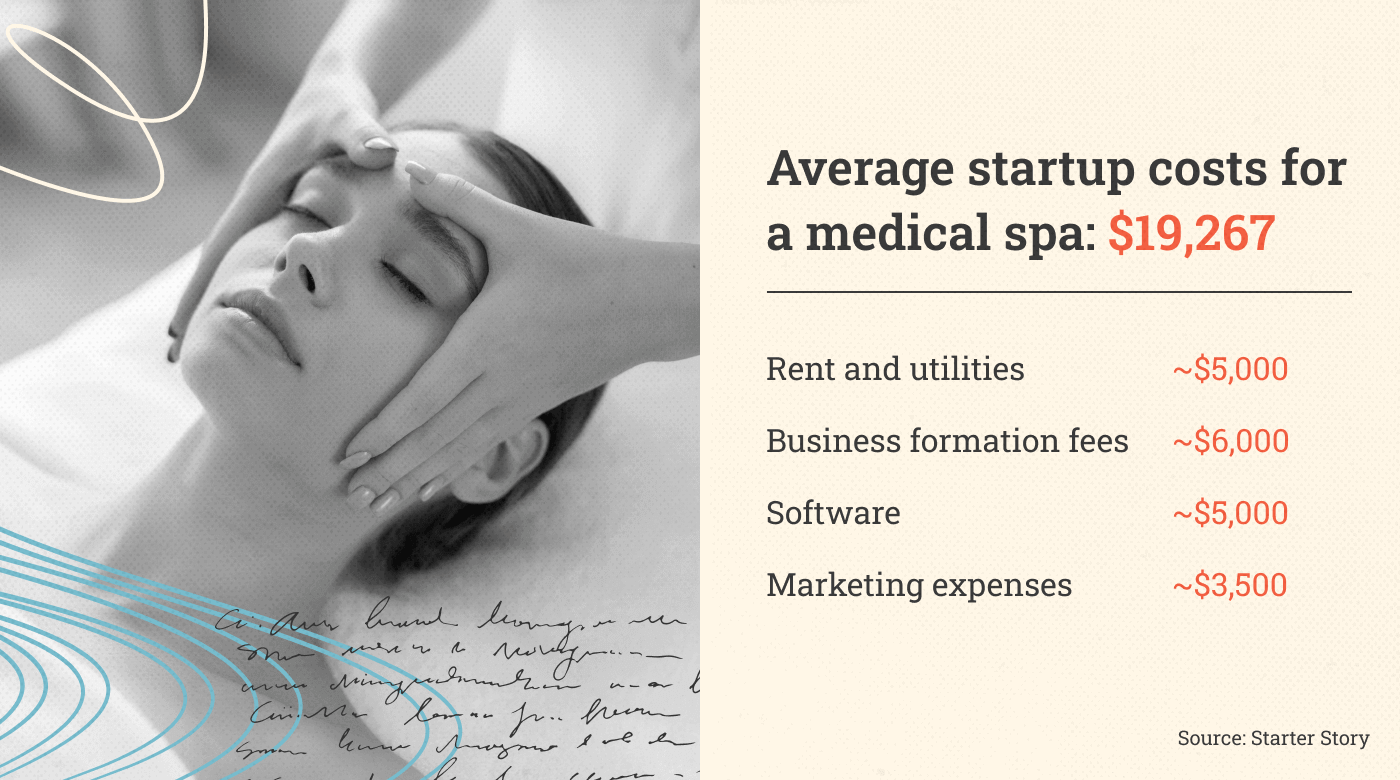
Rent and Utilities: $5,000
Rent and utility expenses include the foundational costs that come with setting up your physical storefront. These include the following:
- Rent: Your rent depends on the location, building size, and demand in the area. Popular urban locations will have a higher rent than rurals areas with less traffic.
- Remodeling: You’ll need to prepare and customize the space to suit your medical spa’s needs. This can include painting, flooring, and necessary renovations.
- Utilities: Utilities include water, electricity, and heating and cooling services, as well as any essential services you need to make your spa a comfortable environment for your clients.
Business Formation Fees: $6,000
To ensure your medical spa is legal and compliant, you’ll need to handle the essential permits and licenses when you set it up. These include the following:
- LLC and Corporations: Get your medical spa registered as a Limited Liability Company (LLC) or Corporation to protect your assets and create a separate legal entity for your business.
- Small business insurance: Protect your medical spa with solid insurance coverage in case of any potential liabilities or risks.
- Permit and license fees: Get all the necessary permits and licenses from local authorities to run your medical spa without a hitch.
- Lawyer fees: This one isn’t a must, but it’s really good to have. Legal advice and support will help you make sure everything is legal from day one—letting you avoid headaches later.
Software: $5,000
You’ll need to invest in software to keep your medical spa running smoothly and efficiently. Here are the specifics:
- Medical spa software: All-in-one software that usually includes some CRM components, appointment and staff scheduling, and billing/payment management.
- Customer relationship management (CRM): Use a dependable CRM system to handle client information, appointments, and communication.
- Electronic records management (ERM): Go paperless and organize patient records with an ERM system for easy access and management.
- Accounting software: Keep your finances in check and maintain clear financial records with accounting software.
Marketing Expenses: $3,500
Investing in marketing to promote your medical spa will give you the exposure you need to attract new clients. Here’s an idea of what marketing expenses can include:
- Website domain: Having a domain name that represents your brand makes your spa accessible online.
- Website design: A user-friendly website showcases your services and helps you establish an online presence.
- Signage: Signage can attract local foot traffic and boost your spa’s visibility in the local community.
- Business cards: Professional business cards are great for networking and outreach.
- Advertisement: Targeted advertisements online and offline will help you reach potential clients and increase brand awareness.
How to Choose Medical Spa Equipment
Now, let’s talk gear. Having state-of-the-art equipment will give your medical spa an edge over its competition.
But how do you choose the right medical spa equipment? I’ll walk you through the process.
Research Reliable Suppliers and Brands
Before you dive into a shopping frenzy, determine what types of equipment you need for each service.
Here’s a list of medical spa equipment you might decide on when getting started:
- Massage tables
- Facial beds and chairs
- Injectable tools
- Facial steamers
- Magnifying lamp
- Laser and radiofrequency devices
- Microdermabrasion machines
- Sterilizing equipment
Then, do your research. You want to find reputable suppliers and brands known for their quality and reliability. After all, you wouldn’t want to save a few hundred dollars only to have to replace your gear a few months down the road because it doesn’t work well. And you definitely don’t want your equipment to let you down mid-treatment.
Having top-of-the-line gear can also give your medical spa a competitive edge. Doing your homework in this area will pay off big time.
Consider Long-Term Cost and ROI
I get it—the upfront costs for leasing or owning spa equipment can make you second-guess yourself. But we’re playing the long game here.
Investing in advanced spa equipment may seem pricey now, but think of the long-term benefits it’ll bring. High-quality equipment tends to last longer, reducing the need for frequent replacements and repairs.
You’ll want your investment to do more than just break even. The medical spa industry is booming, with a whopping $15 billion in revenue in 2022. Every medical spa sees an average of 283 non-surgical aesthetic patient visits per month, with each patient spending around $536 per visit. That’s some serious ROI potential right there.
So look past the initial costs, and think about how much revenue each piece of equipment can bring you over time.
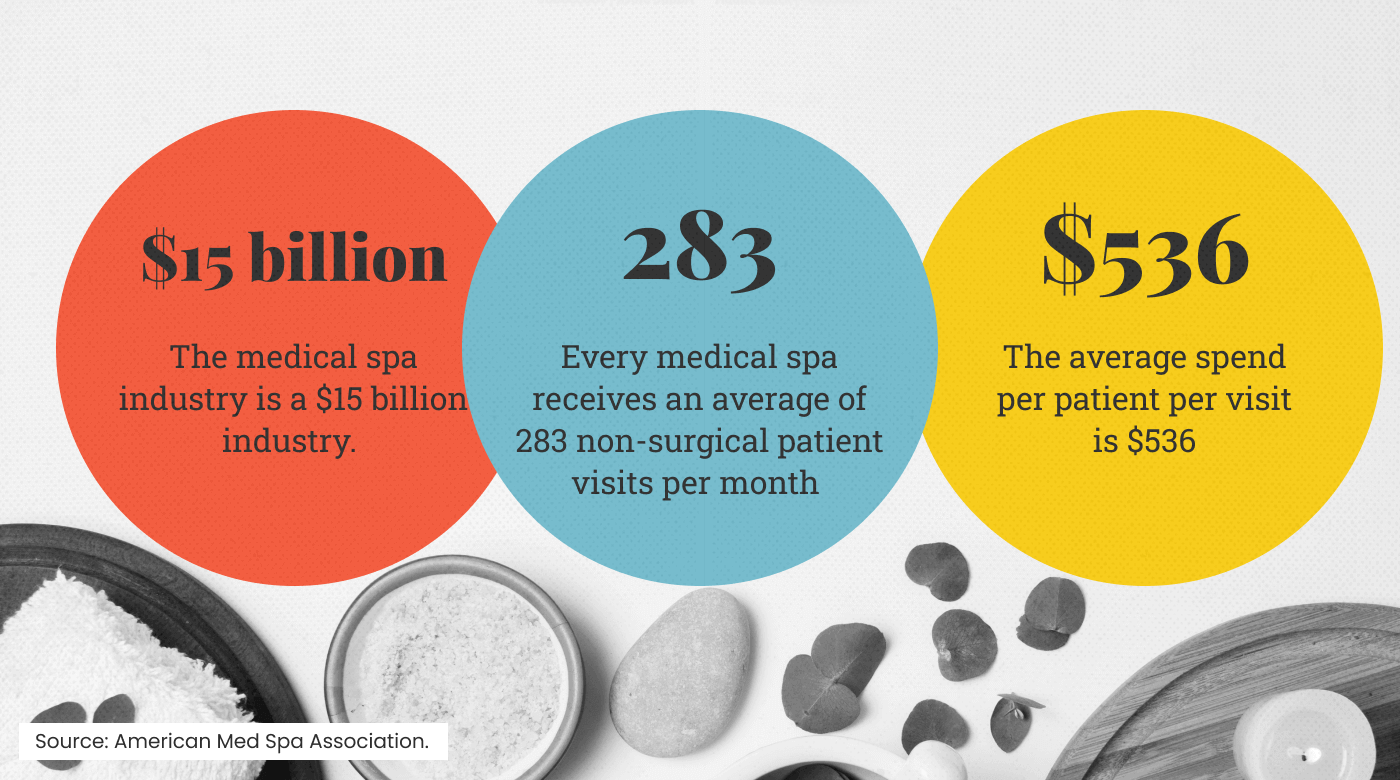
Ensure Regulatory Compliance
Here’s how to approach compliance for your medical spa: no shortcuts and no fuss—just good old legal compliance. You need to make sure your equipment is FDA-approved or CE-certified, depending on your region. Additionally, all your equipment and procedures will need to follow local regulations and licensing requirements.
Keeping up with regulatory requirements not only protects your clients but also builds trust and credibility in your treatments and brand.
Test and Demo Your Equipment
Nobody likes unpleasant surprises. Always, always, always test out your equipment before committing to it. You can ask for demos or trials to see the equipment in action and decide whether it would be a good fit for your business.
Doing this helps you minimize any chances of buyer’s remorse and make decisions that’ll benefit your medical spa in the long run.
An Insider’s Guide to Opening a Medical Spa
Now that you have an idea of what pieces you’ll put in place and the costs of opening a medical spa, let’s look at what steps you can take to turn this dream into a reality.
Ready to open your own medical spa? Here’s a step-by-step guide that covers everything from money to marketing.
1. Choose Your Business Model
The first step is choosing a business model that aligns with your vision. There are a couple of questions you need to nail down before you get started. Here are just a few of them:
What services will you offer?
Define the range of services you’ll provide to your clients, taking equipment, costs, and potential demand into account. A good way to answer this question is to do market research to determine what services will solve your target market’s pain points.
Are they looking for anti-aging and rejuvenation? Is the focus on organic beauty and skincare? How important is hair removal?
Once you know what your future clients are likely to prefer, you can tailor your services accordingly.
How big will your business be?
Will it be an intimate boutique spa or a bigger establishment with multiple treatment rooms? Determining the size of your business will impact your budget, staffing needs, and capacity to serve clients.
Will it be a franchise or an independent business?
Weigh the pros and cons carefully before making this choice. Being independent allows for more creative freedom and control over your brand, but it also means taking on more responsibilities.
On the other hand, joining a franchise gives you immediate brand recognition. However, you’ll need to follow specific guidelines and share profits with the parent company.
2. Write a Business Plan
A comprehensive business plan improves your likelihood of success because you’ll be more confident in your decisions and prepared for what’s in store. A business plan will also help you secure funding.
Start by outlining your projected expenses, including initial startup costs, monthly overhead, and equipment investments.
Then, figure out your revenue sources, such as cosmetic procedures, product sales, and membership packages. If you don’t know where to start, researching industry averages and benchmarks will give you a better idea of what to expect and how to set realistic financial goals.
Next, analyze your spa’s potential growth by identifying your target audience and competitors.
Take advantage of resources online, and use a medical spa business plan template to structure your plan. Specifically, this template will guide you through sections like the executive summary, market analysis, marketing strategies, and financial projections.

3. Secure Funding
Let’s face it—you need money to open a medical spa. This means impressing the big guns, like banks, investors, and lenders. They’ll want to see a well-crafted business plan that showcases your business’s financial projections and growth strategy.
When presenting your business plan to potential investors or lenders, clearly explain your revenue cycle model and how you plan to achieve profitability. Additionally, showing them you understand your market will improve your chances of securing funding.
Explore different funding options, such as small business loans, lines of credit, or even digging into your personal savings. However, consider the interest rates, repayment terms, and any potential risks associated with each.
Here are the pros and cons of different funding options:
Small Business Loans
Pros:
- Lower interest rates
- Structured repayment plans
- Professional support
Cons:
- Strict eligibility criteria
- Potential collateral requirements
Line of Credit
Pros:
- Flexible access
- Interest on the amount used only
- Convenient for ongoing expenses
Cons:
- Variable interest rates
- Limited borrowing capacity
- Risk of overspending
Personal Savings
Pros:
- No interest or debt
- Complete control over funds
- No approval process
Cons:
- Limited funding
- Personal financial risk
4. Find a Location
Your medical spa’s location can make or break your business. Before committing to any specific place, look into the zoning regulations to make sure the area is properly zoned for commercial businesses.
Accessibility and parking are also critical considerations for attracting clients. Find a location that has ample parking and is easily accessible.
Moreover, do a little scouting for competition in the area. You can even go undercover as a client. Identifying your competitors and understanding their services, pricing, and clientele will help you position your medical spa uniquely and better cater to the needs of your target market.
5. Get Insurance
Insurance might not be the most exciting topic, but trust me—you’ll need it.
First thing’s first: get yourself general liability insurance. This will protect you from all sorts of unexpected mishaps and accidents that might come your way.
Next, there’s professional liability insurance, also known as malpractice insurance. This will shield you against any claims of negligence or mistakes during treatments.
Lastly, protect your staff. Worker’s compensation insurance is a must-have to keep your team protected in case they get injured on the job. Cover your bases and rest easy knowing you’ve got insurance that’ll have your back.
6. Develop Health and Safety Plans
A comprehensive health and safety plan is the backbone of a well-run spa. Your clients, staff, and business as a whole depend on it.
Start by developing a plan for each of the following aspects:
- Biohazards
- Patient privacy
- Hygiene
- Equipment operation
- Medication handling
- Storage
- Risk management
- Disinfection
- Incident reporting
Make sure you’re following industry standards and regulations to the T. Also, train your team on these plans, keep them updated, and have clear protocols in place for any unforeseen situations.
7. Ensure Legal Compliance
I stressed this earlier, but let me say it again—you need to be compliant.
In some states, only licensed medical practitioners can own a medical spa. If you don’t have a medical license, you’ll need to work with a management services organization (MSO) through a management services agreement (MSA).
The MSO handles the business side of things, while the MSA outlines the terms of your collaboration with them. This process ensures your medical spa meets all the legal requirements set by state regulations.
Even in states that let anyone own a medical spa, non-physicians will still need to hire a physician or medical professional to provide the medical services. Each state has different legal requirements, so double-check yours to stay compliant.
Also, don’t forget about compliance with the Health Insurance Portability and Accountability Act (HIPAA). In a nutshell, HIPAA is a US law that keeps patient health information private and secure. The software that you use should support compliance with all the necessary regulations.
8. Hire Your Staff
Your staff represent the heart and soul of your medical spa. So hire the right people with the right skills.
You can determine your ideal team size based on your business model and projected patient volume. You may need medical practice managers, nurse practitioners, aestheticians, receptionists, and support staff.
For a larger medical spa, having a diverse range of professionals with specialized skills will enhance the overall client experience. And for a smaller, more intimate spa, focus on building a close-knit team with a shared commitment.
If budget is a concern, hire multi-skilled medical professionals, like nurse practitioners or aestheticians, who can perform various treatments.
9. Buy or Lease Equipment
To buy or to lease—that’s the question. Before you decide, explore all financing options and leasing arrangements to pick the most cost-effective solution for your budget.
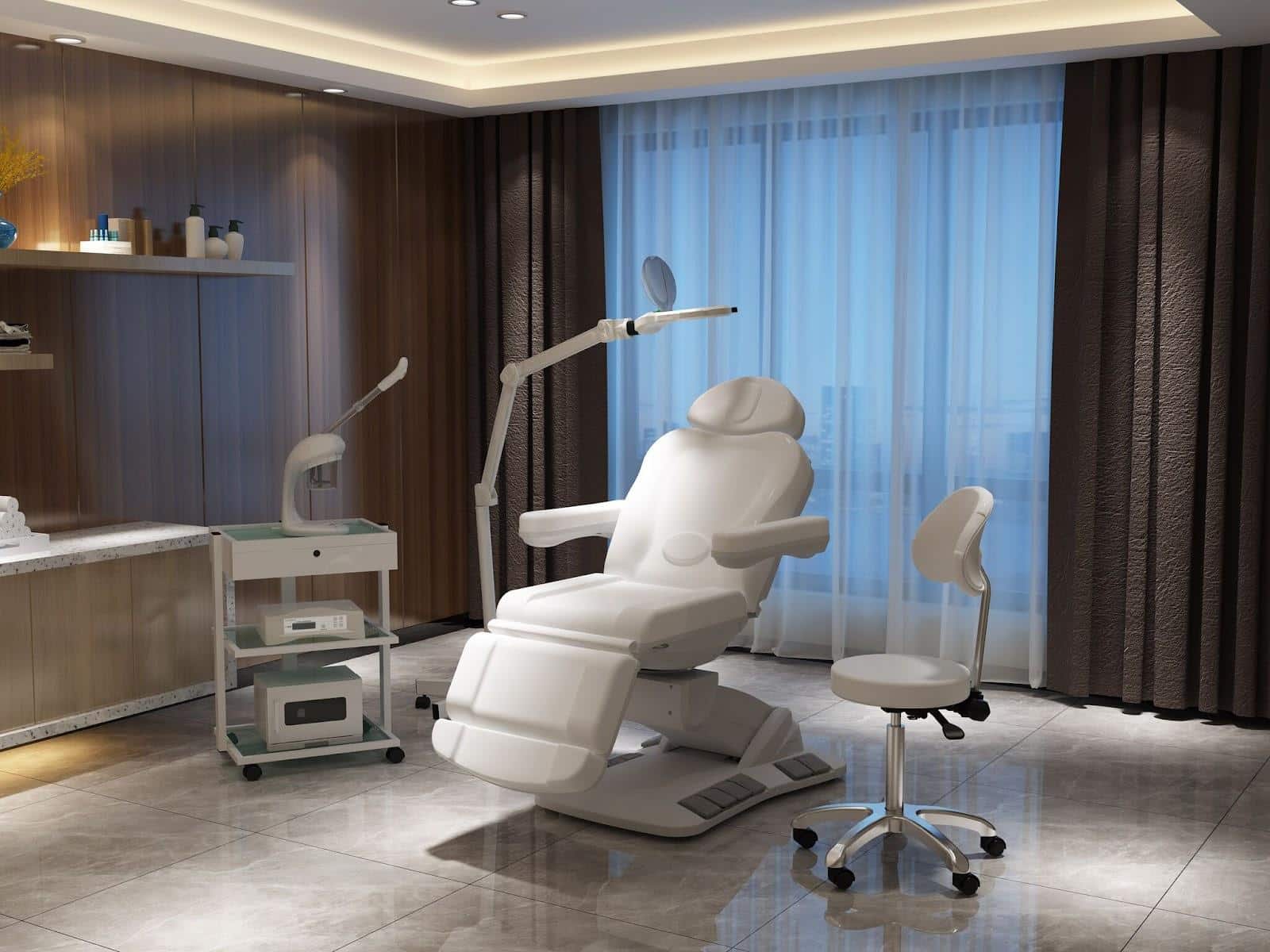
Take a look at my breakdown of leasing vs. buying equipment:
Leasing
Pros:
- Lower upfront costs
- More flexibility to upgrade
- Tax-deductible
Cons:
- Higher overall costs
- Limited ownership
Buying
Pros:
- Long-term savings
- Full ownership
- More assets
Cons:
- Higher upfront costs
- Outdated equipment over time
Whichever option you end up choosing, remember to create a detailed inventory of all equipment, including serial numbers, warranties, and maintenance schedules. This will help you keep track of repairs and maintenance needs, extending the equipment’s lifespan.
Additionally, factor future expansion and scalability into your decision-making process. As your medical spa grows, you may need to upgrade or add equipment to meet new demands.
10. Design Marketing Materials
Let’s not forget about marketing. To come up with a marketing strategy that works, you need to know what your potential clients want.
List your unique selling points and key messages to understand your positioning in the market and see what resonates with your customer base.
With the right marketing materials, you’ll attract new clients, build brand awareness, and effectively communicate your medical spa’s value to potential customers. Also, think about the different marketing campaigns you can run to keep customers engaged. Here’s some inspiration:
- Seasonal offers and discounts
- Referral program
- Membership program
- Local partnerships
- Social media contests
But marketing isn’t just about promoting and selling—it’s also about connecting with your clients and building lasting relationships that foster loyalty.
5 Bonus Tips for Opening a Medical Spa
Here are a few more insights that’ll help you navigate challenges and set your business up for success:
1. Build Your Brand Identity
Build your brand identity with care and intention, as it’s the first impression your customers get. Craft a brand story that connects with your target market on a deeper level and reflects your values, mission, and unique selling points.
The more authentic and relatable your story is, the more people will connect with your business.
Once you have a compelling brand story, incorporate it into a consistent visual identity. Think about your logo, color scheme, and overall design. Consistency across all touchpoints, from your website to marketing materials, will reinforce your brand’s image and leave a lasting impression on your clients.
Brand identity also extends into how you and your staff treat your customers. Providing a personalized and exceptional customer experience will contribute to a positive and memorable brand perception.
2. Personalize the Customer Experience
A customer will always remember how you made them feel. It’s important to provide a personalized experience that leaves the customer feeling good, special, and cared for.
You can gather information about your client’s preferences through consultations and tailor your treatments to fit their needs. Additionally, creating a comfortable and welcoming environment will help make your clients feel at ease during their visit. You can add thoughtful touches, like soothing music, calming scents, and plush furnishings, to further enhance their experience.
Personalized aftercare and follow-up are just as important as clients’ experiences at the spa. Providing detailed instructions on post-treatment care and calling to check in with them can make a huge difference in how they feel about your business—and whether they return.
Another big part of personalizing the customer experience is ensuring that your staff are trained in customer service and understand its importance. Encourage your team to engage with clients, remember their preferences, and build strong relationships with them.
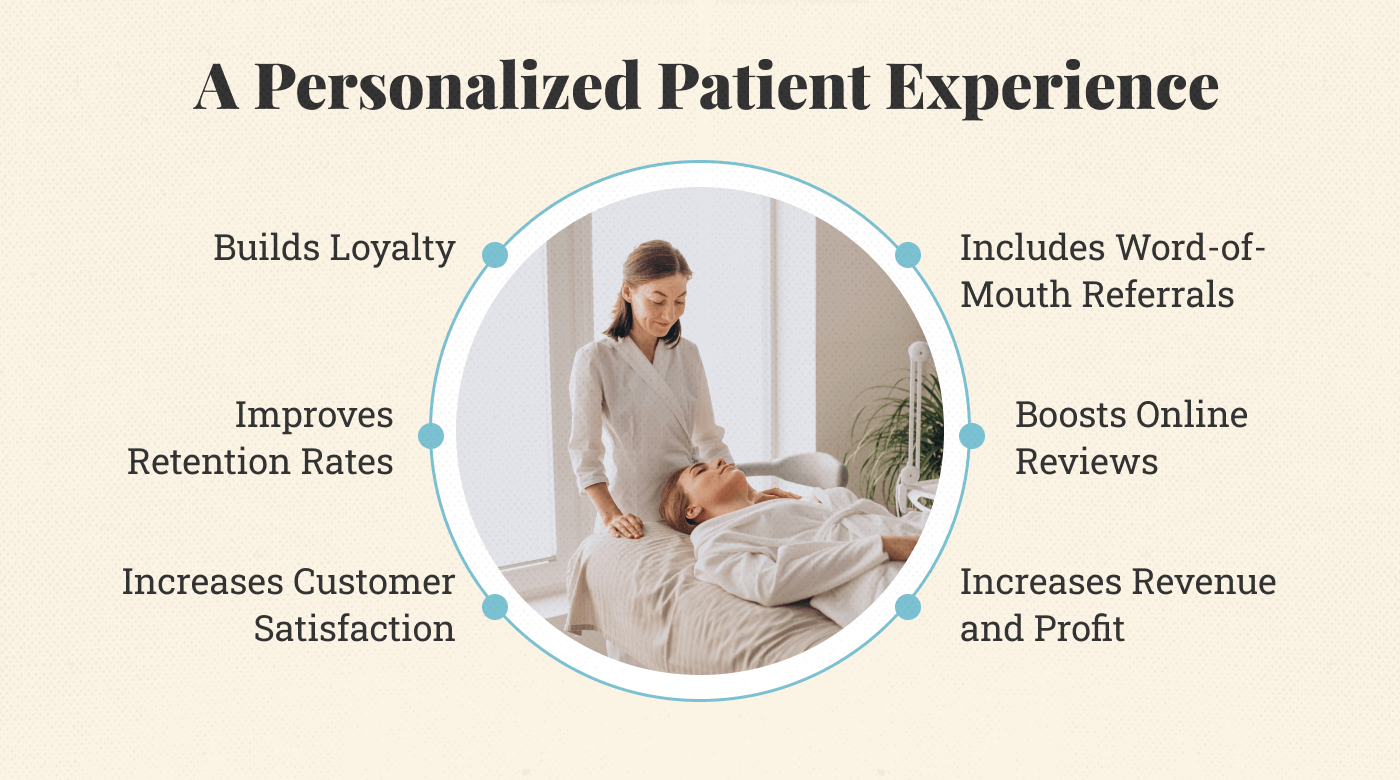
3. Prioritize Staff Training
Above all, your staff is your biggest asset. So, invest in their growth and development to improve the quality of the services your spa offers.
Ongoing education, workshops, and professional development opportunities are great ways to educate and motivate your team. You can also offer specialized training for different treatments so your staff stay up-to-date on the latest industry trends.
If you foster a culture that values continuous learning, you’re halfway to success. One great way to do this is to invite your staff to participate in knowledge-sharing sessions or team discussions where they can share insights, learn from each other’s experiences, and brainstorm new ways to improve.
4. Hold a Soft Launch
Before you go all out, test the waters with a soft launch. This trial run will help point out any issues that you might have missed.
Invite your key stakeholders to be a part of the soft launch, and observe how they react to or handle different scenarios. Ask them to give you feedback afterward, and fine-tune your operations based on that feedback.
A soft launch is also an excellent opportunity to generate presence and excitement in your community. Use social media, events, and word of mouth to create buzz around your medical spa. This initial exposure can help build anticipation and attract potential clients before your official launch.
5. Get Medical Spa Software That Fits Your Needs
I talked about getting software earlier, but the trick is to get medical spa software that works for you. Your software can streamline appointment scheduling, manage inventory efficiently, maintain electronic medical records, handle billing and invoicing, and communicate with your clients.
If you plan on opening a large medical spa with multiple practitioners and a high volume of clients, you’ll probably want to have robust and scalable software like Mindbody or Kareo. However, if you’re starting with a smaller medical spa, you’ll likely find that simple and user-friendly software, like Square Appointments or Vagaro, will be sufficient.
Additionally, look for software that offers marketing automation features to simplify your promotional efforts. Centralizing all these functions in one platform can save you time, reduce your manual tasks, and improve your business’s overall efficiency.

Start Your Medical Spa Journey
Opening a successful medical spa requires careful planning, dedication, and industry savviness. From choosing the perfect business model to securing funding and complying with legal requirements, each step is crucial for long-term success.
This step-by-step guide can give both seasoned spa managers and aspiring entrepreneurs actionable knowledge so they can open a medical spa business that flourishes.
Good luck with your new venture!



